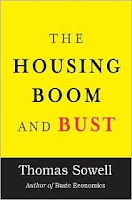The Housing Boom

Sowell begins chapter one by chronicling the housing boom, as reflected in the rise of the median sales price for single-family homes by one-third from 2000 to 2005 ($143,600 to $219,600).
In some places the rise was even sharper. Over those same years, the median home price in New York rose 79 percent, in Los Angeles 110 percent and in Sand Diego 127 percent. In coastal California, the rise was especially sharp--and so was the later fall. (p. 1)Then he presents the cast of characters that play an important role in the housing market. Obviously there is the local bank from whom the home buyer gets the money to purchase the home. But behind the local bank is a complicated web of other players. (1) The Federal Reserve System that regulates the banks across the country and can take actions that affect interest rates and the money supply. (2) The Federal National Mortgage Association (Fannie Mae) and the Federal Home Loan Mortgage Corporation (Freddie Mac). These are...
two government-created, but privately owned, profit-making enterprises that buy mortgages from banks. By selling these mortgages, banks get money from a 30-year mortgage without having to wait 30 years for monthly payments from home buyers to pay off their debts. With the proceeds from these sales to Fannie Mae aor Freddie Mac, or to other financial institutions, the banks then have money to lend again to create more mortgages from which to profit. (p. 3)(3) The U.S. Department of Housing and Urban Development (HUD), which has authority over Fannie Mae and Freddie Mac. (4) Wall Street firms which "buy mortgages, bundle them together and issue stocks and bonds based on the value of those mortgages."
Wall Street firms have sold these bundles to investors across the country and around the world. Although a California home buyer might borrow the money from a local bank to buy a house, the ultimate source of that money might be in New York or London or Tokyo. (p. 4)With such a wide range of players with very different interests and incentives it becomes a somewhat complex process to follow how the housing market soared to such heights only to plummet to the depths we have seen over the course of the last 18 months or so. But Sowell does an excellent job of untangling the web of responsibility. And not surprisingly, the chief culprits are not the lending agencies, which politicians love to blame, but the politicians themselves who ignore sound economic principles.

Comments